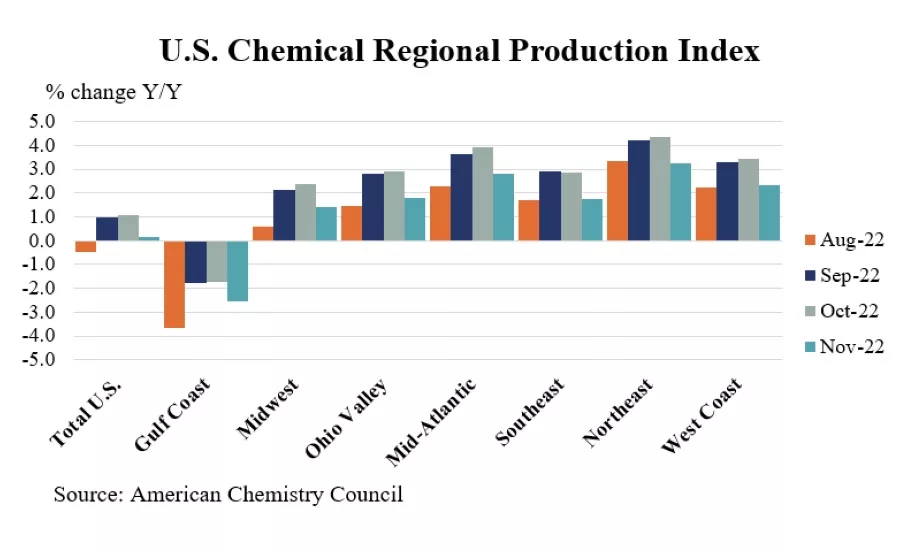ACC Reports U.S. Chemical Production Lower in November

Courtesy of the American Chemistry Council.
The U.S. Chemical Production Regional Index (U.S. CPRI) fell by 0.4% in November following declines of 0.4% in September and 0.3% in October, according to the American Chemistry Council (ACC). Chemical output was lower than a month ago in all regions, with the largest declines in the Gulf Coast, home to much of the nation’s basic industrial chemical and synthetic materials capacity. Reportedly, the declines reflect sluggish output in several end-use manufacturing industries and weak export markets.
The U.S. CPRI is measured as a three-month moving average (3MMA), and was developed by ACC to track chemical production activity in seven regions of the United States. On a 3MMA basis, chemical production within segments was mixed in November. There were gains in the production of coatings, adhesives, and other specialty chemicals; industrial gasses; synthetic dyes and pigments; and other inorganic chemicals. These gains were offset by lower production of plastic resins, organic chemicals, synthetic rubber, manufactured fibers, consumer products, and fertilizers and crop protection chemicals.
As nearly all manufactured goods are produced using chemistry in some form, manufacturing activity is an important indicator for chemical demand. Manufacturing output was flat in November on a 3MMA basis. The 3MMA trend in manufacturing production was mixed, with gains in the output of food and beverages, appliances, motor vehicles, aerospace, fabricated metal products, machinery, computers and electronics, foundries, rubber products, printing, and apparel. Compared with November 2021, U.S. chemical production was essentially unchanged (up 0.1%). Chemical production was higher than a year ago in all regions, except the Gulf Coast.
The U.S. CPRI is based on information from the Federal Reserve, and as such, includes monthly revisions as published by the Federal Reserve. The U.S. CPRI includes the most recent Federal Reserve benchmark revision released on June 28, 2022. To smooth month-to-month fluctuations, the U.S. CPRI is measured using a three-month moving average. The reading in November reflects production activity during September, October, and November.
For more information, visit: https://www.americanchemistry.com/.
Looking for a reprint of this article?
From high-res PDFs to custom plaques, order your copy today!





